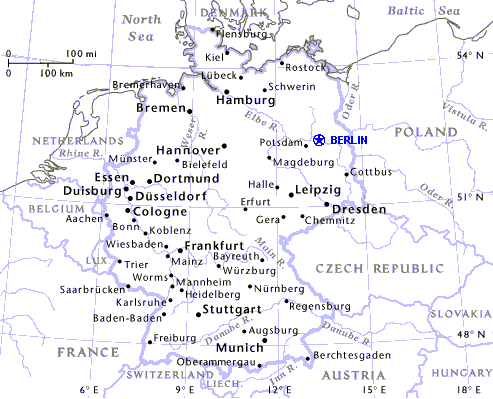Area
Population
Religion
Language
Literacy
Life Exp.
Yet German unity is relatively new. Disparate Germanic principalities, once tethered to the Holy Roman Empire, were set adrift by the Peace of Westphalia in 1648. Real union eluded the Germans until 1871, when the king of Prussia became kaiser of Germany. The new emperor owed his empire to a cunning politician, Otto von Bismarck.
Bismarck's creation had the makings of a colossus: industrial potential, prolific farms, an enviable army, and overseas possessions. Defeat in World War I cost Germany its empire and military machine and left the nation staggering under heavy reparations. Inflation and unemployment hounded the shaky Weimar Republic. By 1933 a demoralized population had turned to Adolf Hitler and the Nazi party. Under Hitler, Germany rearmed and invaded neighboring countries, triggering the Second World War. Obsessed with racial "purity," Hitler singled out Jews, Gypsies, and other groups for extermination. Millions perished at Nazi death camps.
When Germany surrendered in 1945, it lost eastern lands to the Soviet Union and Poland. The Allies carved the rest of the country, and its capital, Berlin, into four zones. Meant to be temporary, the partition persisted as the U.S.S.R. and other Allied powers clashed over a communist or capitalist unified Germany. In 1949 the American, French, and British zones formed the Federal Republic of Germany (West Germany), and the Soviet Union established the German Democratic Republic (East Germany). The Berlin Wall went up in 1961. When it came down three decades later, West Germany's then chancellor, Helmut Kohl, navigated a year of tense diplomacy to fuse the halves of his sundered nation.
With 82 million people, Germany contains the largest European population outside Russia. Workers from Turkey, Italy, Yugoslavia, and Greece supplement the native labor force in making high-tech products and quality consumer goods for export.
